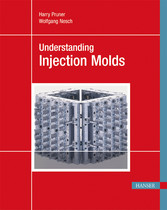Harry Pruner, Wolfgang Nesch
Understanding Injection Molds
Table of Contents
8
Preface
14
1 Basic Mold Design
16
1.1 Assemblies of an Injection Mold
16
1.1.1 Phases of Design
17
1.1.2 Stability of Thermosets Molds
18
1.1.3 Wear in Thermoset Molds
18
1.2 Nozzle Side
19
1.2.1 Sprue Bushing
20
1.2.2 Decompression
21
1.2.3 Strainer Nozzles
22
1.2.4 Nozzle Side of Thermoset Materials
23
1.2.5 Nozzle Side of Elastomer Molds
23
1.3 Ejector Side
24
1.3.1 Ejector Device
25
1.3.1.1 Ejector Set with Ejector Pins
25
1.3.1.2 Stripper Plate
25
1.3.1.3 Mushroom Ejector
26
1.3.1.4 Air Ejector
26
1.3.1.5 Ejector System for Thermoset Mol
27
1.3.1.6 Ejector System for Elastomer Mol
27
1.3.2 Draft Angles
28
1.3.3 Ejector Coupling
29
1.4 Buoyancy Forces in the Mold
30
1.5 Mold Protection
31
1.5.1 Light Barrier/Failure Scale
31
1.5.2 Infrared Mold Protection
31
1.5.3 Vision Systems
32
1.6 Mold Cavity Pressure/Mold Filling Co
33
1.7 Simulation of the Filling Process (M
34
1.8 Demolding Force
35
1.9 Ventilation
36
1.9.1 Ventilation by Displacement
36
1.9.2 Ventilation by Vacuum
37
1.10 Support Bars, Support Plates, and S
38
1.11 Mold Clamping Plate and Centering R
39
1.11.1 Mold Clamping Plate
39
1.11.2 Centering Ring
39
1.12 Core Pullers
40
1.13 Mold Structure in Elastomer Process
41
2 Types of Demolding in Two-Platen Molds
42
2.1 Molded Parts without Undercuts
42
2.2 Molded Parts with Undercuts
43
2.2.1 Elastic Stripping
43
2.2.2 Demolding through Sliders
44
2.2.3 Demolding with Jaws (Split Molds)
45
2.2.4 Collapsible Cores
46
2.3 Molded Parts with Internal and Exter
47
2.3.1 Internal Thread
47
2.3.2 External Thread
47
2.3.3 Unscrewing Device
47
2.3.3.1 Types of Unscrewing
48
2.3.3.1.1 Unscrewing when the Mold is Cl
48
2.3.3.1.2 Unscrewing for an Attached Str
48
2.3.3.1.3 Unscrewing during Upward Motio
49
2.3.3.1.4 Unscrewing the Stripper Plate
49
2.4 Molded Parts with Threads, Forcibly
50
2.5 Unscrewing Gears
51
3 Gate Technology
52
3.1 Distribution Systems
52
3.1.1 Distribution System with Demolded
53
3.1.1.1 Cold Runner
53
3.1.1.2 Three-Platen Distributor
54
3.1.2 Distribution System, Remaining in
55
3.1.2.1 Insulating Runner
55
3.1.2.2 Hot Runner
56
3.1.2.2.1 Advantages of a Hot Runner
56
3.1.2.2.2 Hot Runner, Internally Heated
57
3.1.2.2.3 Hot Runner, Externally Heated
58
3.1.2.2.4 Multiple Connections
60
3.1.2.2.5 Needle Shut-Off Nozzles
61
3.1.2.2.6 Hot Mold Halves
63
3.2 Gate Technology
64
3.2.1 Solidifying Gate, Remaining on the
65
3.2.1.1 Direct Gate
65
3.2.1.2 Pinpoint Gate
66
3.2.1.3 Fan and Ring Gate
67
3.2.1.4 Sprue Gate
68
3.2.1.5 Film Gate
69
3.2.2 Automatically Separated Gate
70
3.2.2.1 Tunnel Gate
70
3.2.2.2 Whip Gate
71
3.2.2.3 Hot Edge Gate (Lateral Injection
72
3.2.2.4 Hot Runner Nozzles
73
3.3 Distribution System for Thermosets a
74
3.3.1 Demolding with the Molded Part for
75
3.3.1.1 Cold Runner for Thermosets
75
3.3.2 Demolding with the Molded Part for
76
3.3.2.1 Cold Runner for Elastomers
76
4 Standard Parts
78
4.1 Mold Designs
78
4.2 Mold Guide Elements
79
4.3 Demolding Elements
80
4.4 Equipment for Mold Temperature Contr
81
4.5 Mold Quick-Change Systems
82
4.6 Latch Conveyors
83
4.7 Hot Plates for Thermosets and Elasto
84
4.8 Brushing Units for Elastomers
85
5 Temperature Control
86
5.1 Temperature Control Channels
86
5.2 Temperature Distribution
87
5.2.1 Temperature Distribution in Thermo
88
5.2.2 Temperature Distribution in Elasto
88
5.3 Continuous Cooling
89
5.4 Segmented Temperature Control
90
5.5 Dynamic Temperature Control
91
5.6 Pulsed Cooling
92
5.7 Core Temperature Control
93
5.8 Temperature Measurement
94
6 Special Designs
96
6.1 Stack Molds
96
6.1.1 Stack Molds in Elastomers
97
6.2 Multi-Component Molds
98
6.2.1 Slider Technology (Core-Back)
99
6.2.2 Transfer Process (Handling Transfe
100
6.2.3 Index Plate
101
6.2.4 Hub
102
6.2.5 Rotary disk
103
6.2.6 Paternoster
104
6.2.7 Cube Technology
105
6.2.7.1 Stack Turning Technology
105
6.2.7.2 Double Cube
106
6.2.8 Tandem Mold
107
6.2.9 Multi-Component Molds for Thermose
108
6.3 Thin Wall Molds
110
6.4 Insertion Technology
111
6.5 Fluid Injection Technology
112
6.5.1 Gas Injection (GIT)
112
6.5.1.1 Partial Filling
113
6.5.1.2 Secondary Cavity
113
6.5.1.3 Blow-Back Process
114
6.5.1.4 The Core Pull-Back Process
114
6.5.2 Water Injection (WIT)
115
6.6 Push-Pull Injection Molds
116
6.7 Implantation Injection Molding
117
6.8 In Mold Labeling (IML) Process
118
6.9 Cascade Injection Molding Process
119
6.10 Lost Core Technology
120
6.11 Material-Dependent Special Processe
121
6.11.1 Marbling
121
6.11.2 Micro-Foam Injection Molding (MuC
121
6.11.3 Thermoplastic-Foam Casting Proces
121
6.11.4 PVC Processing
121
6.11.5 Monosandwich Process
122
6.11.6 In-Mold Painting
122
6.11.7 In-Mold Welding
122
6.12 Micro-Injection Molds
123
6.13 Powder Metal/Ceramic Molds
124
6.14 Rapid Prototyping
126
6.15 Rotary Table Molds
128
6.16 Silicone Molds
129
6.17 Injection Blow Molds
130
6.18 Injection Compression Molds
131
6.18.1 Injection Compression Molds in El
132
6.19 Textile Back Injection Technology
133
6.20 Workpiece Carrier System
134
7 Mold Surface Treatment
136
7.1 Common Surface Treatment Processes
136
7.2 Thermal Treatment
138
7.2.1 Vacuum Hardening
138
7.2.2 Laser Hardening
138
7.2.3 Flame Hardening
138
7.3 Thermochemical Treatment
139
7.3.1 Gas Nitriding
139
7.3.2 Plasma Nitriding
139
7.3.3 Carburization
139
7.4 Electrochemical Treatment
140
7.4.1 Hard Chrome Plating
140
7.4.2 Chemical Nickel Plating
140
7.5 Chemical Physical Treatment
141
7.5.1 Chemical Vapor Deposition (CVD) Co
141
7.5.2 Plasma Assisted Chemical Vapor Dep
141
7.5.3 Diamond-Like Carbon (DLC) Coating
141
7.5.4 Physical Vapor Deposition (PVD) Co
141
7.6 Mechanical Treatment
142
7.6.1 High Speed Cutting (HSC) Milling
142
7.6.2 Surface Gloss
142
7.6.3 High-Gloss Polishing
143
7.7 Surface Graining
144
7.8 Steel Selection
145
7.9 Aluminum Molds
146
8 Machining Processes
148
8.1 Sinking Electric Discharge Machining
148
8.2 Wire EDM
149
8.3 Welding
150
8.3.1 TIG-Welding
150
8.3.2 MIG-Welding
150
8.3.3 MAG-Welding
150
8.3.4 Laser Beam Welding
150
8.4 Punching und Drop-Forging
151
8.4.1 Punching
151
8.4.2 Drop Forging
151
8.5 Casting
152
8.6 Galvanized Mold Inserts
153
9 Care, Maintenance, and Storage
154
9.1 Mold Care
154
9.2 Inspection
155
9.3 Maintenance
156
9.4 Storage
157
Index
158
© 2009-2024 ciando GmbH
 Zu Hanser-Fachbuch.de
Zu Hanser-Fachbuch.de
 Warenkorb
Warenkorb
